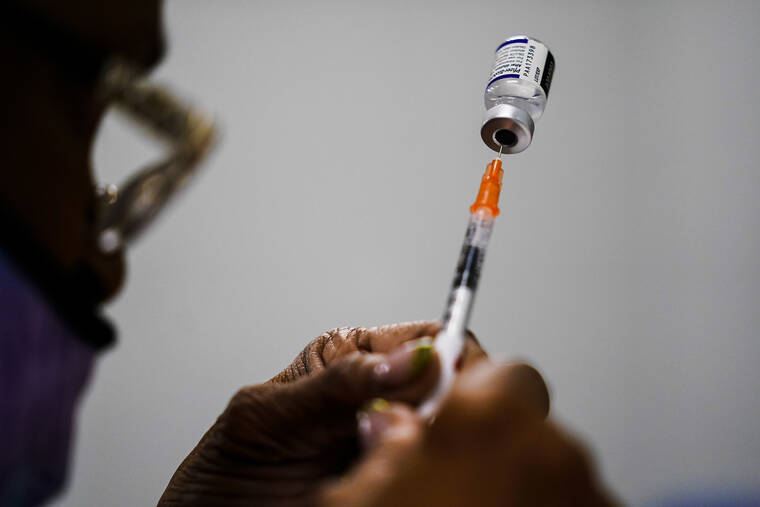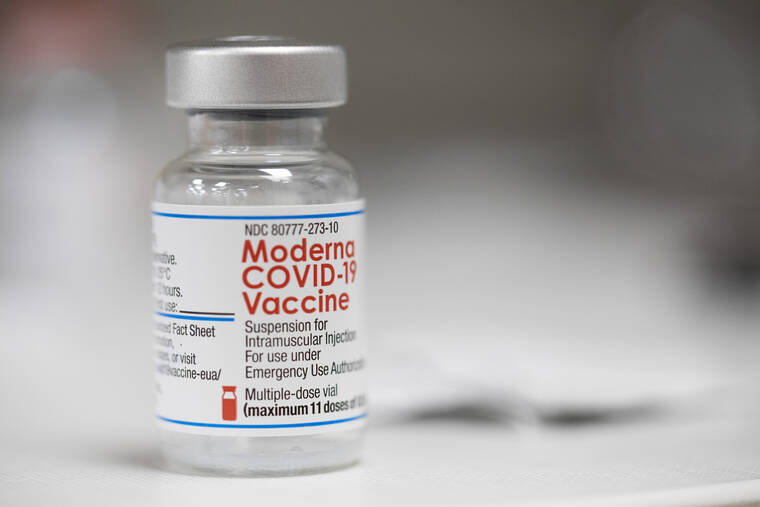US grapples with whether to modify COVID vaccine for fall

FILE - A syringe is prepared with the Pfizer COVID-19 vaccine at a vaccination clinic at the Keystone First Wellness Center in Chester, Pa., Dec. 15, 2021. Pfizer says tweaking its COVID-19 vaccine to better target the omicron variant is safe and boosts protection. Saturday, June 25, 2022 announcement comes just days before regulators debate whether to offer Americans updated booster shots this fall. (AP Photo/Matt Rourke, File)

FILE - A vial of the Moderna COVID-19 vaccine is displayed on a counter at a pharmacy in Portland, Ore. on Dec. 27, 2021. U.S. health authorities are facing a critical decision: whether to offer COVID-19 booster shots this fall that better match the omicron variant even though the coronavirus already has spawned still more mutants. Moderna and Pfizer are testing updated booster candidates, and advisers to the U.S. Food and Drug Administration will debate Tuesday, June 28, 2022, if it’s time for a switch, setting the stage for similar moves by other countries. (AP Photo/Jenny Kane, File)
U.S. health authorities are facing a critical decision: whether to offer new COVID-19 booster shots this fall that are modified to better match recent changes of the shape-shifting coronavirus.
U.S. health authorities are facing a critical decision: whether to offer new COVID-19 booster shots this fall that are modified to better match recent changes of the shape-shifting coronavirus.
Moderna and Pfizer have tested updated shots against the super-contagious omicron variant, and advisers to the Food and Drug Administration will debate Tuesday if it’s time to make a switch — setting the stage for similar moves by other countries.
“This is science at its toughest,” FDA vaccine chief Dr. Peter Marks told The Associated Press, adding that a final decision is expected within days of the advisory panel’s recommendation.
Current COVID-19 vaccines saved millions of lives around the world in just their first year of use. And the Moderna and Pfizer shots still offer strong protection against the worst outcomes — severe illness and death — especially after a booster dose.
But those vaccines target the original coronavirus strain and between waning immunity and a relentless barrage of variants, protection against infections has dropped markedly. The challenge is deciding if tweaked boosters offer a good chance of blunting another surge when there’s no way to predict which mutant will be the main threat.
In an analysis prepared for Tuesday’s meeting, FDA officials acknowledged targeting last winter’s version of omicron is “somewhat outdated” since it already has been replaced by its even more contagious relatives.
“We would obviously like to get it right enough,” Marks said, so that with one more shot “we get a full season of protection.”
Many experts say updated boosters promise at least a little more benefit.
“It is more likely to be helpful” than simply giving additional doses of today’s vaccine, said epidemiologist William Hanage of the Harvard T.H. Chan School of Public Health.
That’s assuming the virus doesn’t throw another curve ball.
“We’re following rather than getting ahead which is so vexing — that we haven’t come up with a better variant-proof vaccine,” said Dr. Eric Topol, head of the Scripps Research Translational Institute, who has urged a major government push for next-generation immunizations.
Adding to concern about a winter COVID-19 wave is that about half of Americans eligible for that all-important first booster dose never got it. An updated version might entice some of them.
But “we do need to change our expectations,” said Dr. William Moss of the Johns Hopkins Bloomberg School of Public Health, who noted that studies early in the pandemic raised unrealistic hopes of blocking even the mildest infections. “Our strategy can’t be booster doses every couple of months, even every six months, to prevent infections.”
The top candidates are what scientists call “bivalent” shots — a combination of the original vaccine plus omicron protection.
That’s because the original vaccines do spur production of at least some virus-fighting antibodies strong enough to cross-react with newer mutants — in addition to their proven benefits against severe disease, said University of Pennsylvania immunologist E. John Wherry.
“Being able to push the boost response a little bit in one direction or the other without losing the core is really important,” he said.
Moderna and Pfizer found their combo shots substantially boosted levels of omicron-fighting antibodies in adults who’d already had three vaccinations, more than simply giving another regular dose.
Recipients also developed antibodies that could fight omicron’s newest relatives named BA.4 and BA.5, although not nearly as many. It’s not clear how much protection that will translate into, and for how long.
Antibodies are a key first layer of defense that form after vaccination or a prior infection. They can prevent infection by recognizing the outer coating of the coronavirus — the spike protein — and blocking it from entering your cells.
But antibodies naturally wane and each new variant comes with a different-looking spike protein, giving it a better chance of evading detection by remaining antibodies. Separate studies published this month in Nature and the New England Journal of Medicine show the newest omicron relatives are even better at dodging antibodies — both in the vaccinated and in people who recovered from the original omicron.
That first booster people were supposed to get strengthened immune memory, helping explain why protection against hospitalization and death is proving more durable. If the virus sneaks past antibodies, different defenders called T cells spring into action, attacking infected cells to curb illness.
“T cells recognize the virus in a fundamentally different way,” not hunting for disguised spike protein but for parts of the virus that so far haven’t been altered as much, said Penn’s Wherry.
Still, as people get older, all parts of their immune system gradually weaken. There’s little data on how long T cell protection against COVID-19 lasts or how it varies with different mutations or vaccines.
Wherry and dozens of other scientists recently petitioned the FDA to quit focusing solely on antibodies and start measuring T cells as it decides vaccination strategy.
The Biden administration has made clear that it needs Congress to provide more money so that if the FDA clears updated boosters, the government can buy enough for every American who wants one. And Dr. Anthony Fauci, the government’s top infectious disease expert, told Congress last week more research funding also is critical to create better next-generation vaccines, such as nasal versions that might better block infection in the nose or more variant-proof shots.
“The virus is changing and we need to keep up with it,” Fauci, said.


